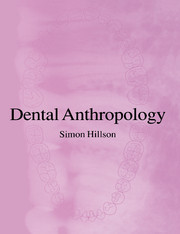Book contents
- Frontmatter
- Contents
- Acknowledgements
- Abbreviations
- 1 Introduction to dental anthropology
- 2 Dental anatomy
- 3 Variation in size and shape of teeth
- 4 Occlusion
- 5 Sequence and timing of dental growth
- 6 Dental enamel
- 7 Dentine
- 8 Dental cement
- 9 Histological methods of age determination
- 10 Biochemistry of dental tissues
- 11 Tooth wear and modification
- 12 Dental disease
- 13 Conclusion: current state, challenges and future developments in dental anthropology
- Appendix A: Field and laboratory methods
- Appendix B: Microscopy
- References
- Index
13 - Conclusion: current state, challenges and future developments in dental anthropology
Published online by Cambridge University Press: 05 June 2012
- Frontmatter
- Contents
- Acknowledgements
- Abbreviations
- 1 Introduction to dental anthropology
- 2 Dental anatomy
- 3 Variation in size and shape of teeth
- 4 Occlusion
- 5 Sequence and timing of dental growth
- 6 Dental enamel
- 7 Dentine
- 8 Dental cement
- 9 Histological methods of age determination
- 10 Biochemistry of dental tissues
- 11 Tooth wear and modification
- 12 Dental disease
- 13 Conclusion: current state, challenges and future developments in dental anthropology
- Appendix A: Field and laboratory methods
- Appendix B: Microscopy
- References
- Index
Summary
Identification and basic sorting
The anatomy of human teeth is very well known, because of the needs of dental surgery, so there is rarely any difficulty in identifying closely even a fragmentary tooth from archaeological or forensic remains. When several individuals form a mixed, fragmentary burial, then the teeth are amongst the best elements for determining how many individuals are present, and which fragments belong to which individual. This can be done simply, by matching morphological variation or state of wear, or it can be done with precision, by matching the sequences of enamel or dentine layers (pages 177 & 189). The challenge is not so much in establishing methodologies although there are still problems, for example, in distinguishing worn cheek teeth, but more in educating anthropologists and archaeologists more widely in identification skills. Recovery of teeth, particularly in juvenile material, is still not always complete and misidentified specimens are still found in museum stores. One major aim of this book is therefore to summarize the main identification criteria that are useful in anthropology.
Metrical variation
The basic diameters of the crown have been measured for many years, and there is general agreement about their definition. They can be recorded reliably, with low rates of observer error, even though they need to be measured to a high level of precision in comparison with bone measurements because teeth are relatively small and comparisons between taxa, populations and sexes often involve mean differences of fractions of a millimetre.
- Type
- Chapter
- Information
- Dental Anthropology , pp. 288 - 294Publisher: Cambridge University PressPrint publication year: 1996



